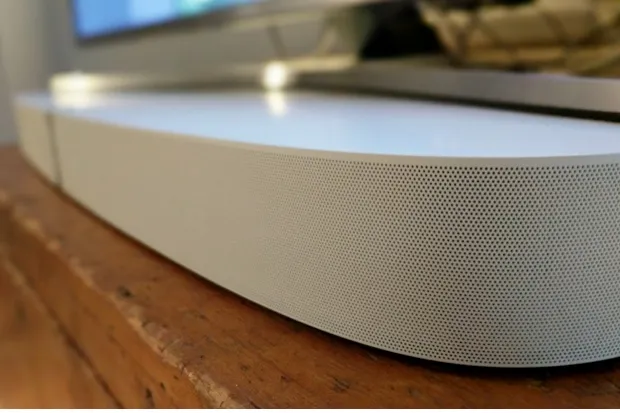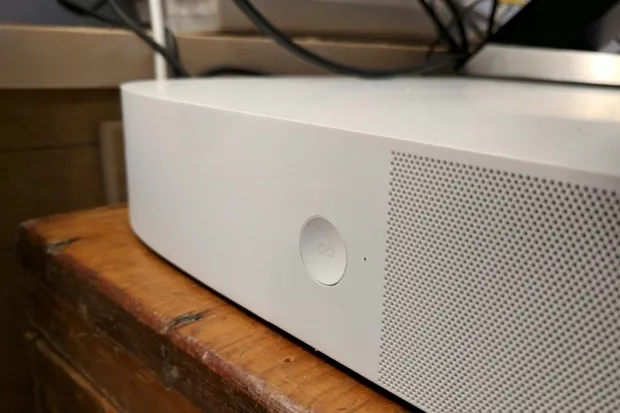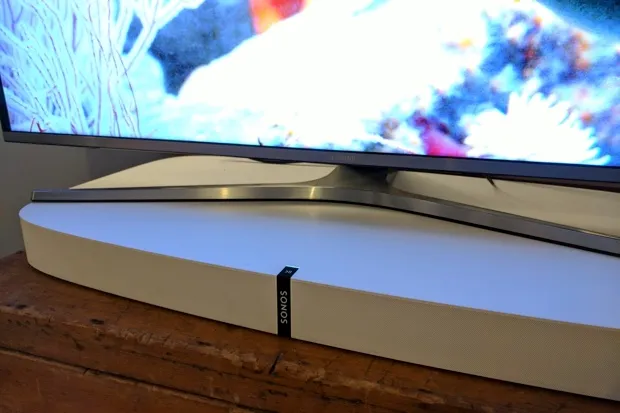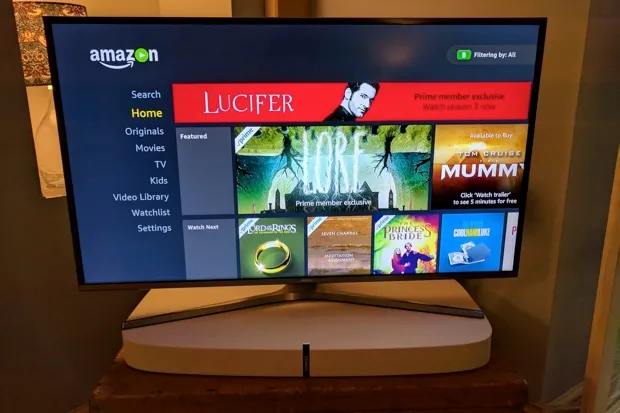The Sonos Playbase is the second dedicated TV speaker fromSonosafter the Playbar, designed for the 70 per cent of us who can’t (or won’t) find space on a wall to hang a 4K television. With high expectations from the muiltiroom speaker specialists, whose recent Alexa-enabled Sonos One smashed it out the park, can this speaker be as big on sound as it is price? Let’s test it out and see.
First impressions
With no sense of hyperbole my life was changed a few years back when I decided to get a soundbar and subwoofer to beef up the sound on my flatscreen TV. Yes, it was fine when I was living in squalor in a six-bed house in Dalston, but as I moved through life and moved into a flat where I could actually keep my tele in the living room the lack of decent sound became glaringly obvious. Now I’m practically living the high life, with an actual house and family, and I need to make adult design choices about shades of paint and how to arrange pillows. In other words, there is no chance the TV is taking up a whole wall, and a sound bar plonked in front isn’t going to cut it. Which makes a TV sound base a pretty decent option for folks like me, rapidly running out of options when it comes to getting good sound out of a flatscreen.
So, how does the Sonos Playbase look? Pretty good if you ask me. It has a large footprint, which means there will be a lot of space surrounding it, but this is one of the inevitable drawbacks of putting flatscreen on a wide base. My 40-inch TV perches comfortably on top with plenty of load to spare - it can carry up to 35kgs, so realistically a good TV under 70 inches should be fine -but at 8.6kg kg the unit itself was surprisingly heavy, so a good firm base is needed to put it on. This probably won’t be a problem for most as even the rickety wooden box I’ve been lugging around with me from childhood seems to be holding everything up alright.

Up close, minimal would be the best way to describe how the Playbase looks, with only three touch buttons on the top for volume, skipping tracks and play/pause, and the front grill is covered in more than 40,000 almost-imperceptible and differently-sized holes, which help spread out the sound. This is good, it looks elegant and understated meaning the whole unit doesn’t scream “look at me”, showing off instead with the sound it makes. Personally, I think it looks tidy nestled beneath my television, but my wife isn’t sold just yet. She has a problem with it being a littletooobvious given it is in Sonos’ classic white, so the black version might be more to her tastes should we ever decide to stump up and get one. But thenyouwon’t be buying the Playbase because it looks nice - it’s all about how it sounds.
Sound investment
Setup is ridiculously easy, almost too easy as there are only three inputs on the back – power, digital audio and an Ethernet port should you desire to use one. That means there is no audio line-in if you want to plug an amp or record player into it, and no HDMI pass through, so everything has to be hooked into a Sonos Connect or routed through your television’s digital output (and at the mercy of whatever signal that can push out) into the back of the Playbase. Good for elegance (how very Sonos), but if you were planning on adding this to an already established home cinema system this might be a stumbling block. That said, once you’re plugged in and spent five minutes carefully guided through the app setting the whole thing up you might want to reconsider your rig anyway.

Within moments, the living room of my home was filled with beautifully crisp and astonishingly loud sound. StickingStar Warson, the Playbase’s curved edges around the front (as well as those individually-sized holes) manages to throw out sound to all corners of the room, meaning X-wings go swooshing past your ears in incredible detail and explosions are thunderous. During the more sedate scenes, voices come through naturally and unforced, but when things get noisier they can be overpowered by the more cinematic effects. There is a speech enhancement option in the app which tones down the bass a bit and keeps speech at a constant volume, and similarly, Night Sound makes loud bits quieter in general for your neighbour’s sanity, and while these do make a noticeable effect on the sound, I’m not convinced these make enough of a difference to use. At times I was still struggling a little to hear speech above the general mayhem of my TV choices, but that said, it still sounds significantly better than any otherspeakersI’ve used to date.
Adding a Sonos Sub will separate the sound for an even more boomy bass experience (although for movie watching I’m not sure if it even needs it) and pairing two smaller Sonos speakers as surround speakers will give you an all-encompassing experience. I do have two Play:1s, so I was able to try these out, and although my setup wasn’t ideal (perhaps they were a little close to my head precariously balanced on the back of the sofa), they certainly added to the mix adding a bit more mid-range and helping out with speech. Using the Trueplay feature on an iOS device should make everything sound even more spectacular, but if you’re on android (like me) you’re out of luck.
Sour notes
On that note, where the Playbase lets itself down a bit is when it comes to music, and it’s something that i should have predicted given the speech issues I noticed. Where Sonos’ standalone audio players excel at producing rich sound from such small units, the Playbase is probably a bit too heavy at the low end and bright at the top to let vocals really ring out. Hypothetically, adding the Sonos Sub to take the pressure off the Playbase or adding a pair of Play Ones could give that midrange a bit more breathing space, but overall music doesn’t quite hit the high bar set by Sonos’ other speakers like the Play:5. That’s not to say blasting out the sort of prog-rock nonsense I listen to doesn’t sound marvellous, it does, and if you want to have one sound system in your living room the Playbase is still an exceptionally good option, it’s just that for £699, a dedicated stereo system will make sweeter music for your ears. But then music alone is not what you’d be buying the Playbase for.

Aside from the lack of inputs, the Playbase has one more flaw, which, though isn’t serious, seems something of a glaring omission – Alexa support. Given the Playbase came out not too long before the Sonos One, it seems like an oversight that they didn’t add any capacity for voice support into the actual system. The idea of sitting in the living room and just asking your TV to play the next episode ofStranger Thingsseems like an opportunity missed, and although you can skirt around the issue by adding an Amazon Dot, this seems like an unnecessary intervention on an already pricey system.
On a side note, another problem I have is the app. Although it has improved since I first tried the updated version when Itested the Sonos One, it is still awful and less intuitive than previous versions. This isn’t so much a problem when using the Playbase as part of your home cinema as the app automatically switches to the correct setting when you turn the TV on, but as part of a multiroom speaker setup it lets the whole system down. It’s a minor grumble and one I expect Sonos to improve with future updates.
Technical specs
Price: £699,sonos.com
Speakers: 10 amplified speaker drivers – six mid-range, three tweeters, and one woofer with 10 Class-D digital amplifiers.
Connections: Optical input (DOLBY DIGITAL and stereo)
Dimensions: 58 x 720 x 380 mm
Weight: 8.6 kg – can carry up to 35kg
Interface: Capacitive touch controls for volume up/down, previous/next track, and play/pause.

Verdict
Rarely does something that looks (and weighs) so much like a paving slab bring such enjoyment into anyone’s life, but the Sonos Playbase easily does. As a replacement to an existing stereo setup or sound bar, there are few options that come close to the ease and simplicity of the Playbase, and the the sound quality is richly deserving of the high price tag. Although I wouldn’t suggest getting one as your main speaker system if you are an audiophile, it excels at what it is designed to do, which is to provide incredibly rich and detailed sound for watching TV with a minimal footprint. Whatever flaws, missteps and issues it does have can easily be swept under the carpet when the overall package is this good.
